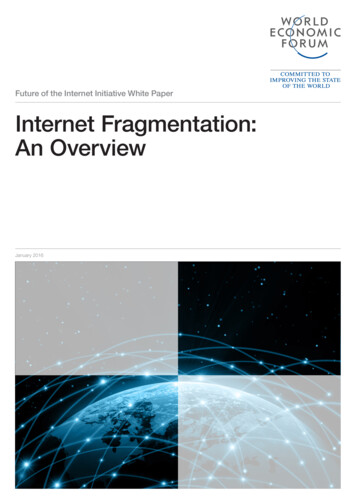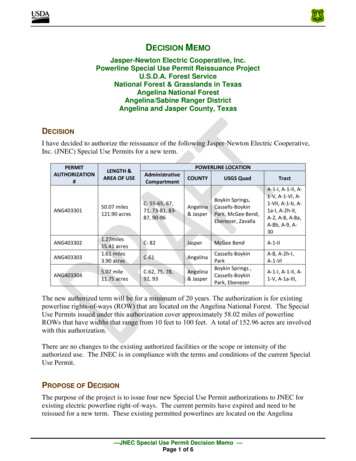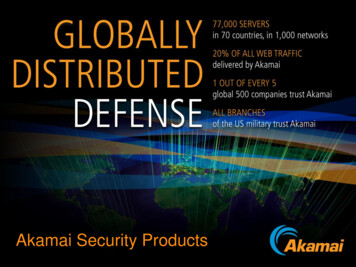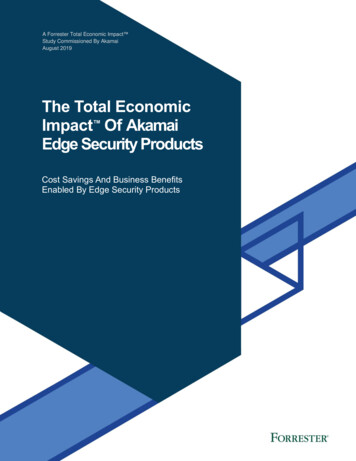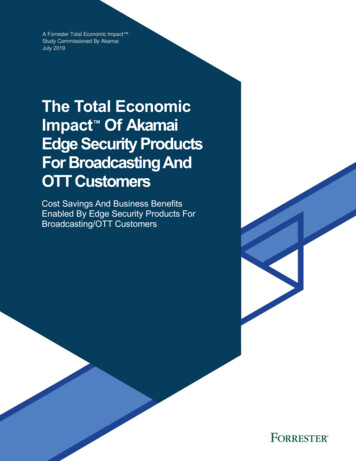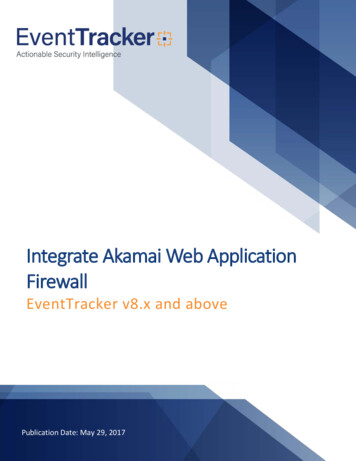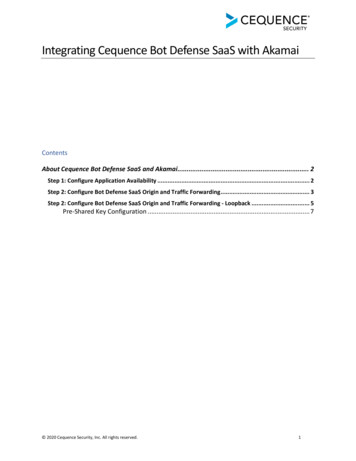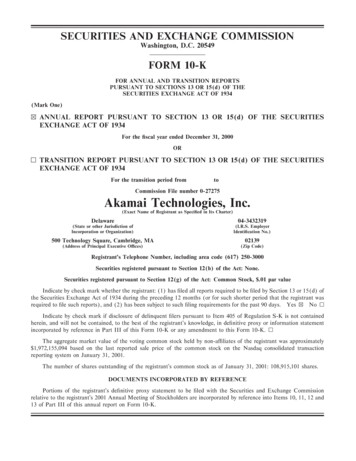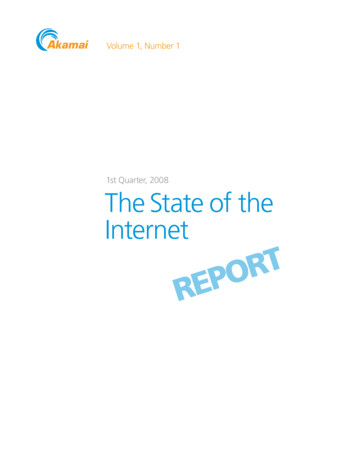
Transcription
Volume 1, Number 11st Quarter, 2008The State of theInternetTROPRE
Table of Contents1. Introduction32. Security42.1 Attack Traffic, Top Originating Countries42.2 Attack Traffic, Top Target Ports52.3 Distributed Denial of Service (DDoS) Attacks62.4 Web Site Hacks73. Networks83.1 Outages83.2 De-Peering Events93.3 Routing Issues93.4 Significant New Connectivity104. Internet Penetration114.1 Unique IP Addresses Seen By Akamai114.2 Internet Penetration115. Geography2125.1 High Broadband Connectivity: Fastest International Countries135.2 High Broadband Connectivity: Fastest U.S. States145.3 Broadband Connectivity: Fast International Countries145.4 Broadband Connectivity: Fast U.S. States165.5 Narrowband Connectivity: Slowest International Countries165.6 Narrowband Connectivity: Slowest U.S. States17 2008 Akamai Technologies, Inc. All Rights ReservedФайл загружен с http://www.ifap.ru
IntroductionAkamai’s globally distributed network of servers allows us to gather massive amounts ofinformation on many metrics, including connection speeds, attack traffic, and networkconnectivity/availability/latency problems, as well as user behavior and traffic patterns onleading Web sites.Starting in the first quarter of 2008, Akamai will be aggregating and analyzing this datain conjunction with other publicly available information to publish a quarterly “State ofthe Internet” report. This first report includes baseline data on distributed denial of service(DDoS) attack traffic and global broadband connectivity and penetration rates as observedby Akamai. Future reports will explore trends in this data. In addition, each report willhighlight significant Internet events, including attacks, outages, and Web site trafficpeaks.DDoS attack traffic in the first quarter of 2008 continued to target exploits that wereidentified years ago, suggesting that there is still a significant population of insufficientlypatched systems connected to the Internet. During the quarter, there were severalhigh-profile Internet outages, de-peering events, and route hijackings. These problemsimpacted millions of users across multiple networks, significantly degrading networkperformance and availability. On the bright side, however, broadband adoption statisticswere encouraging, with Akamai observing a large percentage of connections at speedsover 2 Mbps for many countries and U.S. states. 2008 Akamai Technologies, Inc. All Rights Reserved3
Section 2: SecurityAkamai maintains a distributed set of agents deployed across the Internet that serve tomonitor attack traffic. Based on the data collected by these agents, Akamai is able toidentify the top countries that attack traffic originates from, as well as the top ports targetedby these attacks. (Ports are network layer protocol identifiers.) This section, in part, providesinsight into Internet attack traffic, as observed and measured by Akamai, during the firstquarter of 2008.In addition, published reports indicated that distributed denial of service (DDoS) attacks andWeb site hacking attempts continued unabated in the first quarter, impacting thousandsof Web sites. This section also includes information on selected DDoS attacks and Website hacking attempts as published in the media during the first quarter of 2008. Note thatAkamai does not release information on attacks on specific customer sites, and that selectedpublished reports are simply compiled here.2.1 Attack Traffic, Top Originating CountriesDuring the first quarter of 2008, Akamai observed attack traffic originating from 125unique countries around the world. China and the United States were the two largest trafficsources, accounting for some 30% of traffic in total. The top 10 countries were the sourceof approximately three quarters (75%) of the attacks measured.% TRAFFICCountry% TrafficChina16.77United azil4.75Japan3.56South Korea3.43TurkeyIndiaOther2.692.5325.61Otherther 25.61China 16.77India 2.53Turkey 2.69U.S. 14.33S. Korea 3.43Japan 3.58Brazil 4.75Taiwan 11.82Argentina 5.65Venezuela 8.89% TRAFFIC4 2008 Akamai Technologies,(other)ther) 15.31 Inc. All Rights ReservedMicrosoft RPC 29.66
Otherther 25.61China 16.77India 2.53Turkey 2.69U.S. 14.33S. Korea 3.43Japan 3.58http://isc.sans.org/port. Brazil 4.752.2 Attack Traffic, Top TaiwanTarget11.82Portshtml?port 135Argentina5.65the first quarter of 2008, Akamai observedDuringVenezuela 8.891attack traffic targeted at 23 unique ports– some well known services, and others appearing to be more arbitrarily selected. The mostattacked port, Port 135, was the target of nearly 30% of the attacks observed throughoutQ1 2008. This port is used for remote procedure calls on Microsoft operating systems, andwas used by the Blaster worm back in 2003 to facilitate propagation.1% TRAFFICMicrosoft RPC 29.66ther) 15.31(other)VNC Serverr 1.65Remote Administrator 1.79.79mSymantec SystemCenter Agent 2.933MS SQL Server 6.122DestinationPortPort Use% Traffic135Microsoft RPC29.66139 NETBIOS13.2722SSH12.08445Microsoft-DS11.0280 WWW6.1914336.12MS SQL Server2967Symantec System2.93Center Agents.19WWW 6.19NETBIOS 13.27soft-DS 11.02Microsoft-DS4899 Remote Administrator1.795900VNC server1.65Various(other)15.31SSH 12.08Other ports of interest in the Top 10 include:http://isc.sans.org/port.html?port 1392 Port 139, generally used for Windows network shares, enabling users to share files or foldersacross a network. This port was used by the Klez Family worm, Sircam virus, and Nimdaworm back in 2001 to spread rapidly across networks, as they replicated themselves ontounprotected network shares.2 Port 22, generally used for SSH (secure shell), enabling users to log in to remote machines ina secure fashion. Many attacks targeting this port are employing brute force methods in aneffort to gain access to an account with a weak password. Port 2967, generally used by the Symantec System Center. In 2006, this port was targetedby an IRC Bot that exploited a buffer overflow problem in specific versions of the SymantecAnti-virus software.3http://isc.sans.org/port.html?port 29673% TrafficChina, 16.77One interesting observation about the ports that see the highest levels of attack traffic is thatthey were targeted by worms, viruses, and bots that spread across the Internet several years ago.While that’s not to say that there are not any current pieces of malware that attack these ports, itmay point to a large pool of Microsoft Windows-based systems that are insufficiently maintained,and remain unpatched years after these attacks “peaked” and were initially mitigated withupdated software.Other, 25.61United States, 14.33India, 2.53Turkey, 2.69South Korea, 3.43Japan, 3.56Brazil, 4.75 2008 Akamai Technologies,Inc. All Rights ReservedTaiwan, 11.825
Section 2: Security (continued)Distributed Denial of Service (DDoS) -internettraffic-raw-sewage/4In late March, Arbor Networks4 observed that approximately 2% of all inter-domain Internettraffic was DDoS traffic. The author of a post to the Arbor Weblog noted “Again, this is rawattack traffic, simply meant to exhaust connection state or fill links, nowhere in this mix isspam, phishing, scans, or other malicious or similarly annoying traffic.” The Weblog postalso noted that DDoS traffic has peaked above 5% of aggregated traffic.In January 2008, an online group known as “Anonymous” targeted the Church ofScientology’s Web site with a DDoS attack, in an effort to protest the Church’s policies. Theattack generated up to 220 Mbps of attack traffic at times, according to an article publishedin PC World.5 Comparatively, it was a small attack — a single server can easily generate inexcess of 220 Mbps of traffic. Given that there were likely thousands of larger attacks thatoccurred in the first quarter, this attack is somewhat noteworthy for the attention that itreceived in the mainstream and industry press, while other attacks received little to no ki/pmwiki.php?n 8/03/19/dslreports under 38http://www.nationalpost.com/news/story.html?id 3223729A number of gambling Web sites fell victim to DDoS attacks in February 2008, according tothe ShadowServer Foundation, a group comprised of volunteer security professionals fromaround the world. These Web sites were overwhelmed with a large number of HTTP GETrequests, causing them to become unavailable for hours or days at a time.6Popular broadband Web site DSL Reports was also targeted by a DDoS attack in March2008. According to an article in The Register,7 the attack traffic was primarily comprised ofopen-connection requests from a distributed set of IP addresses – at least 1,100 systemswere believed to have taken part in the attack.While not likely to put a significant dent in the amount of DDoS traffic that floods theInternet, law enforcement officials continue to pursue those responsible for generatingsuch traffic. In January, an Estonian man was fined the equivalent of a year’s salary forhis participation in DDoS attacks that targeted infrastructure within Estonia, knockinggovernment Web sites, banks, and the local media off the Internet.8 In February 2008, policein Quebec arrested 17 suspects that allegedly were participants in a ‘hacker ring’, eachcontrolling approximately 5,000 computers that were used to generate Denial of Serviceattacks, send spam, and steal data.96 2008 Akamai Technologies, Inc. All Rights Reserved
computerworld.com/action/article.do?command viewArticleBasic&taxonomyId 16&articleId 9055858&intsrc hm icious cument.asp?docid id;25717861014Web Site HacksTo no one’s surprise, Web sites continued to be hacked in Q1 2008 – some hackingattempts targeted specific high-profile sites and may have caused minimal damage, whileothers wreaked havoc on thousands of sites by exploiting automated attack vectors. Inaddition to the hacking attempts reported on in the industry press, many more are neverpublicized – the hacking attempts described below are simply intended to be representative.In January 2008, the Pennsylvania State Web site was targeted by hackers allegedly locatedin China.10 According to State officials, the targeted Web pages were taken down forseveral hours as a precaution; they believe that no damage occurred and that no personalinformation was stolen.Also in January 2008, tens of thousands of Web sites were targeted by an automated SQLinjection attack – it is believed that up to 70,000 sites fell victim to the attack.11 Accordingto the Internet Storm Center (ISC), sites impacted by the attack included educational (.edu)and government (.gov) domains, as well as sites belonging to Fortune 500 companies.12In February 2008, an Indian anti-virus firm was the target of a hack that exploited an iFramevulnerability to install the Virut virus onto insufficiently patched Windows systems thatvisited the hacked pages.13 Such exploits have come to be known as “drive-by” downloads,as a user’s system can become infected by simply visiting a hacked Web page.In March 2008, more than 10,000 Web pages on hundreds of Web sites were infected byhackers looking to steal passwords used in popular online games.14 When an insufficientlypatched system visits one of these hacked pages, a JavaScript-based exploit installs apassword-stealing program on the user’s computer, which the hackers can then use to gainaccess to popular online games, where they can steal in-game resources to re-sell for cash. 2008 Akamai Technologies, Inc. All Rights Reserved7
Section 3: NetworksWhile network “events” such as outages, de-peering, and routing issues occur multipletimes a day, every day, the first quarter of 2008 saw some rather significant events thatwere covered in both the industry and mainstream press. Errant ship anchors knockedan entire region of the globe offline in late January and early February, while a routingmisconfiguration created a “black hole” for requests to one of the Web’s most popularvideo-sharing sites in late February. In mid-March, a dispute between two leading backbone/transit providers impacted traffic exchange between the United States and countries inNorthern Europe.3.1 OutagesPerhaps the most noteworthy Internet outage in the first quarter of 2008 resulted fromseveral undersea cables in the Mediterranean Sea being severed. Two cables were severedin late January, and two more went out of service in early February. These cable cutssignificantly impacted Internet connectivity into and out of countries in the Middle East.The two cables account for the majority of international communications capacity betweenEurope and the Middle East, and the cuts reduced bandwidth between the region andEurope by 75%, according to TeleGeography.15According to data collected by Renesys,16 Egypt, Pakistan, Kuwait, and India had the mostnetworks impacted by the cable cut. Data posted to the Renesys blog showed that over1,000 customer networks in Egypt were impacted, with over 900 customer networks inPakistan seeing problems; nearly 500 in India and almost 300 in Kuwait.Data collected by Akamai’s measurement systems showed the impact of these cable cuts onnetwork latency in the region. A visualization available at http://www.akamai.com/mideastoutage shows the degradation in network latency between measurement points to 1.5x, 2x,and 3x or more beyond normal average latency. Data collected by in-region measurementagents showed that delivery of content for Akamai customers was not impacted by thecable cuts. Akamai’s dynamic mapping system ensured that end-user requests were routedto availab
Akamai does not release information on attacks on specific customer sites, and that selected published reports are simply compiled here. 2.1 Attack Traffic, Top Originating Countries During the first quarter of 2008, Akamai observed attack traffic originating from 125 unique countries around the world. China and the United States were the two .
![akamai’s [state of the internet]](/img/11/akamai-soti-q214.jpg)
